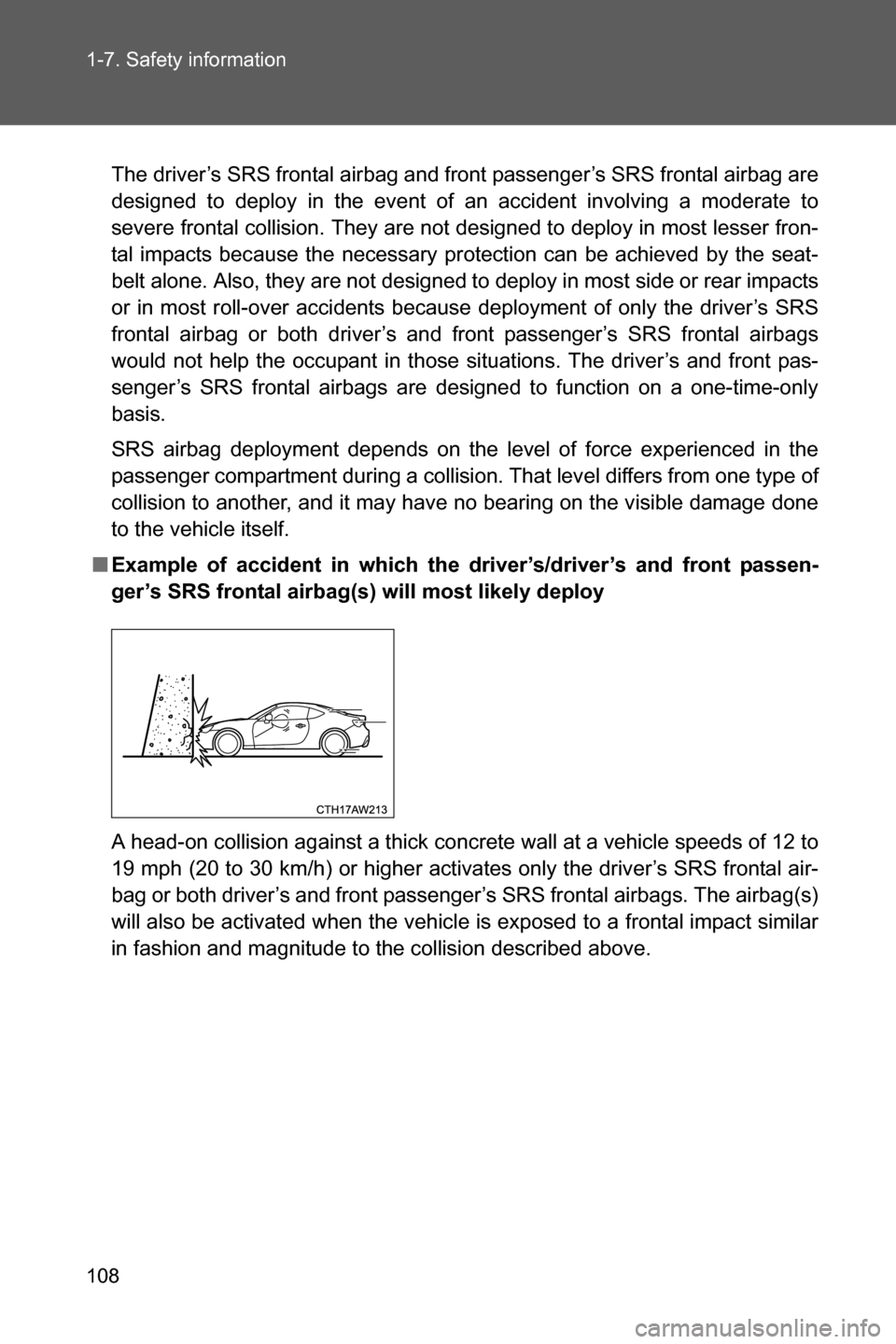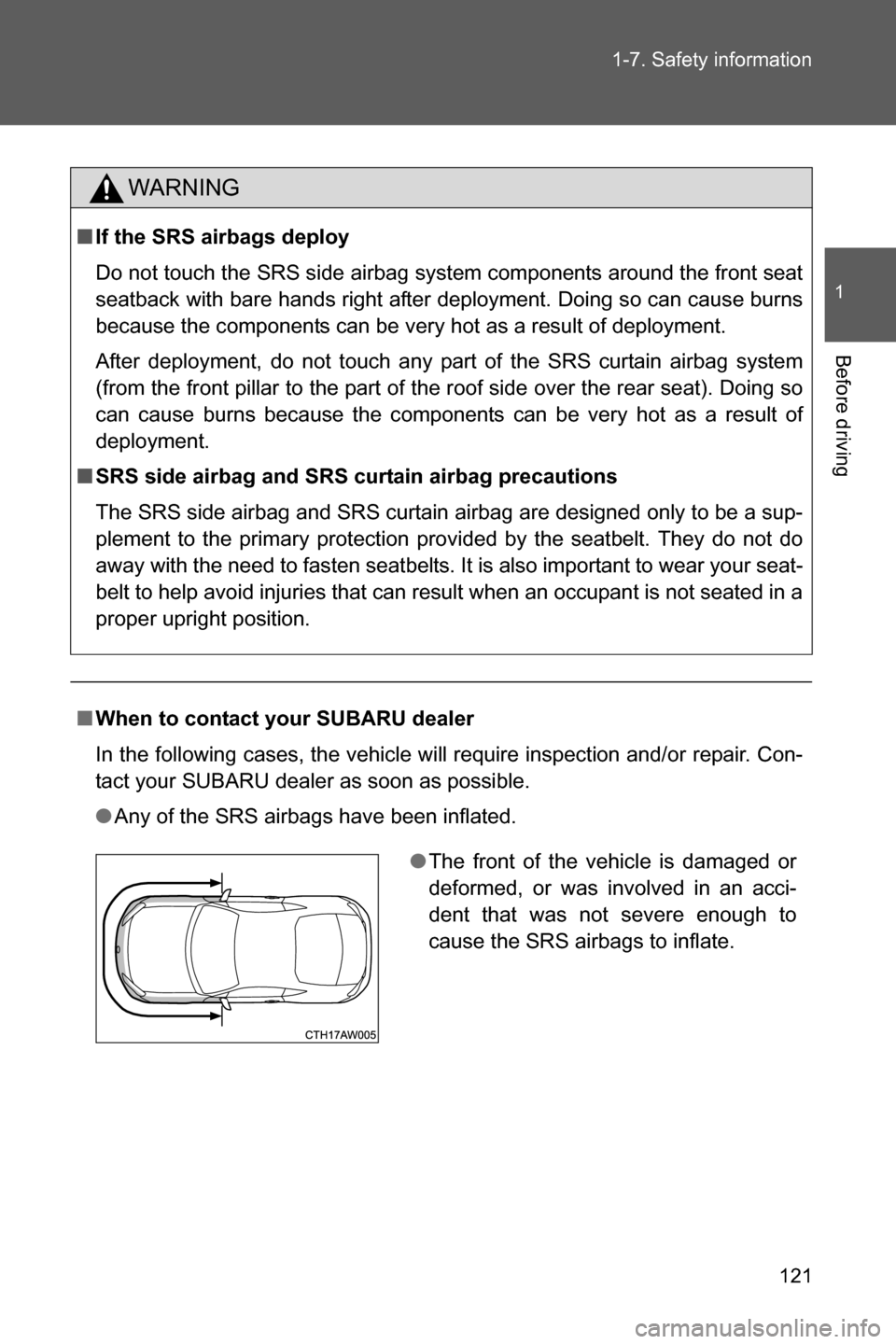2017 SUBARU BRZ Rear seat
[x] Cancel search: Rear seatPage 106 of 540

104 1-7. Safety information
■If the passenger’s frontal airbag OFF indicator illuminates and the ON
indicator turns off even when the front passenger’s seat is occupied by
an adult
This can be caused by the adult incorrectly sitting in the front passenger’s
seat. Turn the ignition switch to the “LOCK” position (vehicles without a key-
less access with push button start system), or turn the push-button ignition
switch off (vehicles with a keyless access with push button start system).
Ask the front passenger to set the seatback to the upright position, sit up
straight in the center of the seat cushion, correctly fasten the seatbelt, posi-
tion his/her legs out forward, and adjust the seat to the rearmost position.
Turn the ignition switch to the “ON” position (vehicles without a keyless
access with push button start system), or turn the push-button ignition switch
to the “ON” mode (vehicles with a keyless access with push button start sys-
tem). If the OFF indicator remains illuminated while the ON indicator remains
off, take the following actions.
●Vehicles without a keyless access with push button start system:
Turn the ignition switch to the “LOCK” position.
Vehicles with a keyless access with push button start system:
Turn the push-button ignition switch off.
●Make sure that the front passenger does not use a blanket, seat cushion,
seat cover, seat heater or massager, etc.
●If wearing excessive layers of clothing, the front passenger should
remove any unnecessary items before sitting in the front passenger’s
seat, or should sit in a rear seat.
●Next, turn the ignition switch to the “ON” position and wait 6 seconds to
allow the system to complete self-checking. Following the system check,
both indicators turn off for 2 seconds. Now, the ON indicator should illu-
minate while the OFF indicator remains off.
If the OFF indicator still remains illuminated while the ON indicator remains
off, ask the occupant to move to the rear seat and immediately contact your
SUBARU dealer for an inspection.
Page 107 of 540

105 1-7. Safety information
1
Before driving
■How to contact the vehicle manufacturer concerning modifications for
persons with disabilities that may affect the advanced airbag system
Changing or moving any parts of the front seats, rear seat, seatbelts, front
bumper, front side frame, radiator panel, instrument panel, combination
meter, steering wheel, steering column, tire, suspension or floor panel can
affect the operation of the SUBARU advanced airbag system. If you have
any questions, you may contact the following SUBARU distributors.
Subaru of America, Inc.
Customer Dealer Services Department
P.O. Box 6000
Cherry Hill, NJ 08034-6000
1-800-SUBARU3 (1-800-782-2783)
Subaru Hawaii
2850 Pukoloa Street, Suite 202, Honolulu,
HI 96819-4467
808-839-2273
Shen’s Corporation dba Prestige Automobile
491, East Marine Corps Drive, Route 1 Dededo,
Guam 96921-6225
671-633-2698
Trebol Motors
P.O. Box 11204, San Juan, Puerto Rico
00910
787-793-2828
Subaru Canada, Inc.
Consumer Support Department
560 Suffolk Court, Mississauga, Ontario
L5R 4J7
1-800-894-4212
There are currently no SUBARU distributors in any other U.S. territories. If
you are in such an area, please contact the SUBARU distributor or dealer
from which you bought your vehicle.
Page 110 of 540

108 1-7. Safety information
The driver’s SRS frontal airbag and front passenger’s SRS frontal airbag are
designed to deploy in the event of an accident involving a moderate to
severe frontal collision. They are not designed to deploy in most lesser fron-
tal impacts because the necessary protection can be achieved by the seat-
belt alone. Also, they are not designed to deploy in most side or rear impacts
or in most roll-over accidents because deployment of only the driver’s SRS
frontal airbag or both driver’s and front passenger’s SRS frontal airbags
would not help the occupant in those situations. The driver’s and front pas-
senger’s SRS frontal airbags are designed to function on a one-time-only
basis.
SRS airbag deployment depends on the level of force experienced in the
passenger compartment during a collision. That level differs from one type of
collision to another, and it may have no bearing on the visible damage done
to the vehicle itself.
■Example of accident in which the driver’s/driver’s and front passen-
ger’s SRS frontal airbag(s) will most likely deploy
A head-on collision against a thick concrete wall at a vehicle speeds of 12 to
19 mph (20 to 30 km/h) or higher activates only the driver’s SRS frontal air-
bag or both driver’s and front passenger’s SRS frontal airbags. The airbag(s)
will also be activated when the vehicle is exposed to a frontal impact similar
in fashion and magnitude to the collision described above.
Page 114 of 540

112 1-7. Safety information
WARNING
■If the SRS airbags deploy
Do not touch the SRS airbag system components around the steering wheel
and dashboard with bare hands right after deployment. Doing so can cause
burns because the components can be very hot as a result of deployment.
■Child restraint precautions
NEVER INSTALL A REARWARD FACING CHILD SEAT IN THE FRONT
PASSENGER’S SEAT EVEN IF THE FRONT PASSENGER’S SRS FRON-
TAL AIRBAG IS DEACTIVATED. Be sure to install it in the REAR seat in a
correct manner. Also, it is strongly recommended that any forward facing
child seat or booster seat be installed in the REAR seat, and that even chil-
dren who have outgrown a child restraint system be also seated in the
REAR seat. This is because children sitting in the front passenger’s seat
may be killed or severely injured should the front passenger’s SRS frontal
airbag deploy. REAR seats are the safest place for children.
Page 115 of 540

113 1-7. Safety information
1
Before driving
SRS side airbag and SRS curtain airbag
The SRS side airbag is stored in the door side of each front seat
seatback, which bears an “SRS AIRBAG” label.
In a moderate to severe side impact collision, the SRS side airbag on
the impacted side of the vehicle deploys between the occupant and
the door panel and supplements the seatbelt by reducing the impact
on the occupant’s chest and waist. The SRS side airbag operates
only for front seat occupants.
The SRS curtain airbag on each side of the cabin is stored in the roof
side (between the front pillar and a point over the rear seat). An “SRS
AIRBAG” mark is located at the top of each front and rear pillar.
In a moderate to severe side impact collision, the SRS curtain airbag
on the impacted side of the vehicle deploys between the occupant
and the side window and supplements the seatbelt by reducing the
impact on the occupant’s head.
If the vehicle is extremely inclined such as when it is involved in a roll-
over accident, the SRS curtain airbags will deploy along with the
driver’s and front passenger’s seatbelt pretensioners to help reduce
the impact to the occupants’ heads.
Your vehicle is equipped with a SUBARU SRS curtain airbag system
that complies with Federal Motor Safety Standard (FMVSS) No. 226.
Page 116 of 540

114 1-7. Safety information
■Operation
The SRS side airbag and SRS curtain airbag can function only when the
ignition switch is in the “ON” position.
The driver’s and front passenger’s SRS side airbags and SRS curtain air-
bags deploy independently of each other since each has its own impact sen-
sor. Therefore, they may not both deploy in the same accident. Also, the
SRS side airbag and SRS curtain airbag deploys independently of the
driver’s and front passenger’s SRS front airbags in the steering wheel and
instrument panel.
A rollover sensor is also located inside the airbag control module.
An impact sensor, which senses impact force, is located in each of the left
and right center pillars, doors and rear wheel houses. Another impact sen-
sor, which also senses impact force, is located under the center of the rear
seats.
If the impact sensor that is located under the center of the rear seats and
one of the center pillar impact sensors or door impact sensors together
sense an impact force above a predetermined level in a side collision, the
control module causes both the SRS side airbag and curtain airbag on the
impacted side to inflate regardless of whether the rear wheel house impact
sensor on the same side senses an impact.
If the impact sensor that is located under the center of the rear seats and
one of the rear wheel house impact sensors together sense an impact force
above a predetermined level, the control module causes only the SRS cur-
tain airbag on the impacted side to inflate.
If the rollover sensor detects rollover of the vehicle, the control module
inflates the SRS curtain airbags. At this time, the driver’s and front passen-
ger’s seatbelt pretensioners also operate at the same time.
Page 117 of 540

115 1-7. Safety information
1
Before driving
After the deployment, the SRS side airbag immediately starts to deflate. The
time required from detection of an impact to deflation of an SRS side airbag
after deployment is shorter than the blink of an eye.
The SRS curtain airbag remains inflated for a while following deployment
then slowly deflates.
The SRS side airbag and SRS curtain airbag deploy even when no one
occupies the seat on the side on which an impact is applied.
When the SRS side airbag and SRS curtain airbag deploy, a sudden, fairly
loud inflation noise will be heard and some smoke will be released. These
occurrences are a normal result of the deployment. This smoke does not
indicate a fire in the vehicle.
The SRS side airbag and SRS curtain airbag are designed to deploy in the
event of an accident involving a moderate to severe side impact collision.
They are not designed to deploy in most lesser side impact. Also, they are
not designed to deploy in most frontal or most rear impacts because SRS
side airbag and SRS curtain airbag deployment would not help the occupant
in those situations.
The SRS curtain airbags are also designed to deploy when the vehicle is in
an extremely inclined state such as during a rollover. They are not designed
to deploy in most lesser inclined state.
Each SRS side airbag and SRS curtain airbag are designed to function on a
one-time-only basis.
SRS side airbag and SRS curtain airbag deployment depend on the level of
force experienced in the passenger compartment during a side impact colli-
sion. That level differs from one type of collision to another, and it may have
no bearing on the visible damage done to the vehicle itself.
Page 123 of 540

121 1-7. Safety information
1
Before driving
WARNING
■If the SRS airbags deploy
Do not touch the SRS side airbag system components around the front seat
seatback with bare hands right after deployment. Doing so can cause burns
because the components can be very hot as a result of deployment.
After deployment, do not touch any part of the SRS curtain airbag system
(from the front pillar to the part of the roof side over the rear seat). Doing so
can cause burns because the components can be very hot as a result of
deployment.
■SRS side airbag and SRS curtain airbag precautions
The SRS side airbag and SRS curtain airbag are designed only to be a sup-
plement to the primary protection provided by the seatbelt. They do not do
away with the need to fasten seatbelts. It is also important to wear your seat-
belt to help avoid injuries that can result when an occupant is not seated in a
proper upright position.
■When to contact your SUBARU dealer
In the following cases, the vehicle will require inspection and/or repair. Con-
tact your SUBARU dealer as soon as possible.
●Any of the SRS airbags have been inflated.
●The front of the vehicle is damaged or
deformed, or was involved in an acci-
dent that was not severe enough to
cause the SRS airbags to inflate.